HandBrake is an open-source video transcoding tool that I use each time I upload a video on YouTube, simply because it will let me crop the beginning or end of a video as needed, can make web optimized videos, has an easy to use user interface, and greatly reduces the size of the video shot with my camera. HandBrake 0.10 has now been released, and it adds H.265 and VP8 encoding support via respectively x265 v1.4 and linbpx, as well as QuickSync video support, but the latter only in Windows. There are also various other changes include OpenCL accelerated scaling.

Handbrake is available for Windows, Mac OS X, and Ubuntu operating systems. It’s part of Ubuntu repository, but if you want the latest version, and support for MPEG-4 (m4v), you’ll need to install it from a PPA:
|
1 2 3 |
sudo apt-add-repository ppa:stebbins/handbrake-releases sudo apt-get update sudo apt-get install handbrake-gtk |
I’ve tested with the video I shot yesterday, to see if I could get half size by using H.265 codec instead of H.264. The original video is a 720p QuickTime video using H.264 codec at 25 fps, and that lasts 10 minutes and 20 seconds. I selected the default settings for both H.264 and H.265, as well as “web optimized” MPEG-4 (.m4v) video container. My computer is powered by an AMD FX8350 octa core processor running Ubuntu 14.04. Here are the results.
| Original | H.264 | H.265 | |
| Size | 1.6 GB | 501.5 MB | 461.9 MB |
| Encoding Time | N/A | 02:40 | 12:28 |
The good news is that I get a size reduction with H.265, but by only about 8%, and it take nearly five times longer to encode the video. Since the original video is about 10 minutes long that means H.265 is encoded at less than than real-time. So even if there’s been great progress compared to previous H.265 video encoding tools, personally, I would not rush to transcode my video library (Handbrake supports batch processing) to H.265 yet, and wait for some more improvement to H.265 support in HandBrake, as the developers stated:
H.265 is now available through x265 1.4. While this encoder is still fairly new, we have seen some promising results come out of it. It’s still under heavy active development and is only going to improve over time!
If you prefer the command line, ffmpeg / avconv also supports H.265 encoding via the same x265 encoder, so performance should be the same.
Via Phoronix

Jean-Luc started CNX Software in 2010 as a part-time endeavor, before quitting his job as a software engineering manager, and starting to write daily news, and reviews full time later in 2011.
Support CNX Software! Donate via cryptocurrencies, become a Patron on Patreon, or purchase goods on Amazon or Aliexpress




